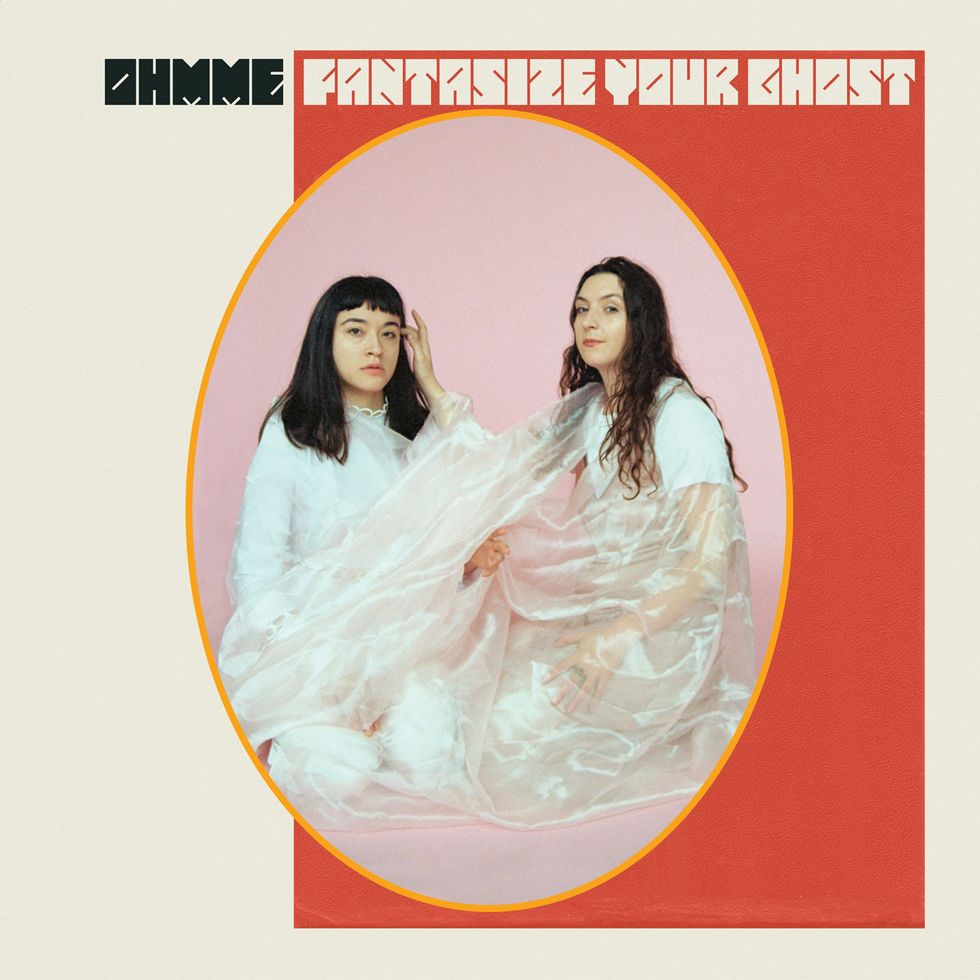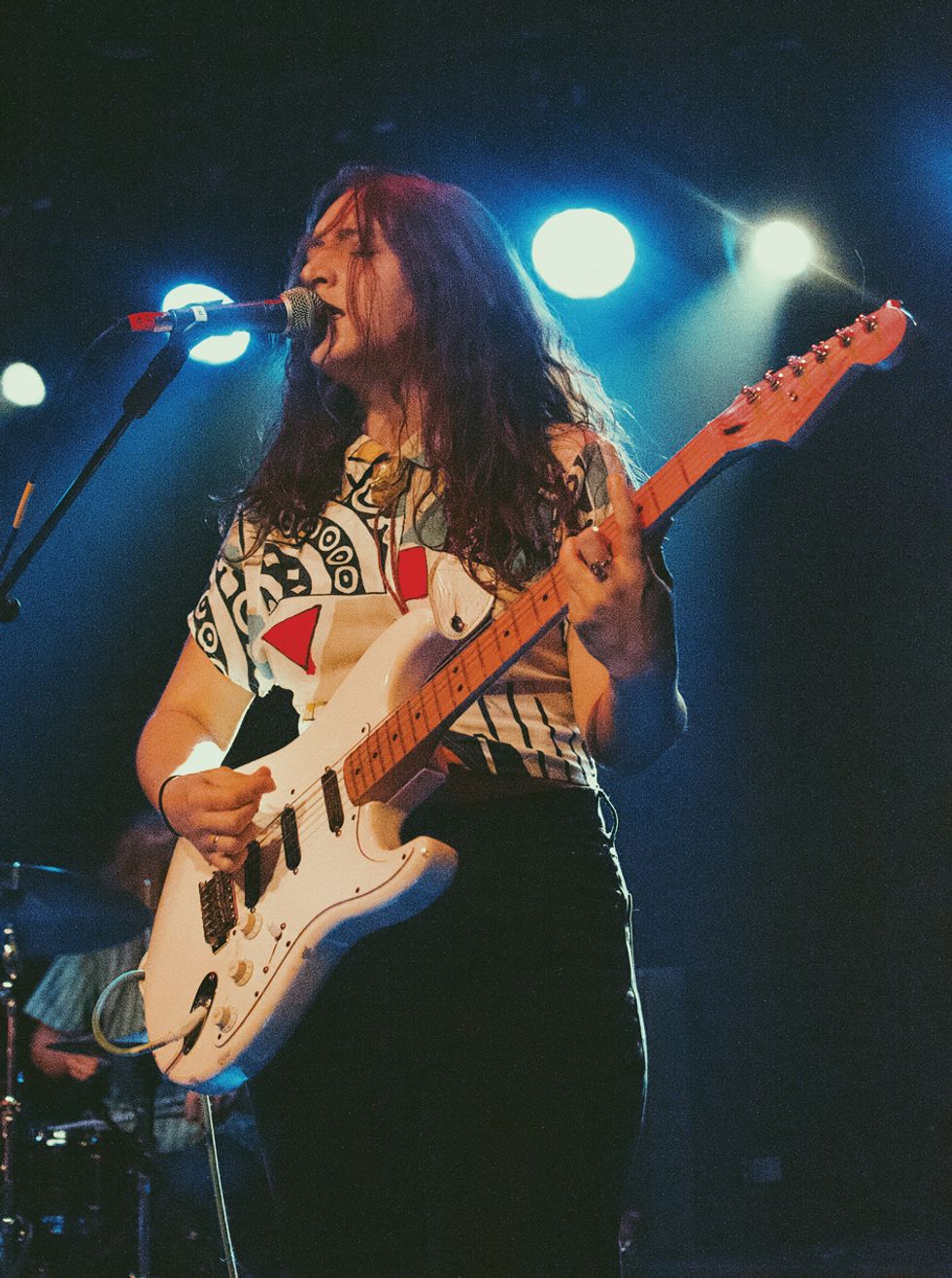Walking a high-wire between melody and noise, adventurous guitarists Sima Cunningham and Macie Stewart have crafted a distinctive approach to indie-rock that frames the unconventional side of electric guitar within approachable and catchy songwriting. As the band Ohmme, which is completed by drummer Matt Carroll, these denizens of Chicago’s improvisational music scene have toured with hometown heroes Wilco and Tortoise, as well as folk-rockers Iron & Wine, and alt-rockers the Ophelias and the Joy Formidable—a testament to the wide dimensions of their sound. With their latest album, Fantasize Your Ghost, Ohmme have honed that sound into its most interesting form yet.
Cunningham and Stewart, who formed Ohmme in 2014, are both classically trained pianists, and Stewart also plays violin. They began their respective journeys with the electric guitar around the same time, with the shared desire to say something different with the instrument. Stewart saw the guitar as a fresh tool for composing and a new canvas for the lessons she’d learned studying piano and violin. Cunningham tended more toward the off-kilter side of the instrument, with a love of controlled chaos. A mutual penchant for textural, anti-rock playing and unusual arrangements, and time spent worshipping at the altar of Brian Eno and Robert Fripp, helps to further tie their approaches together.
Stewart and Cunningham’s guitars and voices dance effortlessly around each other throughout Fantasize Your Ghost in a way that’s instinctual and impressive, without sacrificing the sanctity of the songs. They hide tricky arrangement concepts in often-playful earworms, and their vocal harmonies have a beatific and effervescent sonic quality that’s as appealing as they are unique. And while the album has cutting-edge-pop appeal, it also offers shades of New York City’s ’80s no wave movement’s spirit and quirkiness (“Ghost”), heaps of skronk-and-fun texture (“Selling Candy”), and killer tones aplenty. It’s difficult to tell where Cunningham’s contributions end and Stewart’s begin on Fantasize Your Ghost, and ex-Deerhoof member Chris Cohen’s production decorates these 10 songs in a way that adds flair without burying the duo’s phenomenal weaving.
Armed with a pair of Fender Strats and, mostly, some simple pedals, Ohmme’s sonic magic relies on unexpected arrangements and sophisticated musical ideas, rather than gear-based gimmicks. Premier Guitar spoke to the guitar-wielding dyad about creating their second album, the intuitive side of their musical relationship, the very different reasons they’re both dedicated Strat players, and lessons learned on the road from Wilco’s Jeff Tweedy.
What’s the X factor that makes the bond between you so strong?
Macie Stewart: Sima and I get along really well, but we’re kind of opposites in how we go through the world. We both have an affinity for improvising and following our intuition, and that brings us together, and we have a very similar goal for what we want our music to be, but we like to accomplish things in different ways and there’s always a good push/pull because of that. I think that push/pull is why it works so well, but also why we’ve found our own distinct niches within the larger idea that we have for Ohmme.
Sima Cunningham: Interplay is such a big part of our sound, and because we play the same instrument we always think about how we can take a single idea and pull it apart for two sides of the stage and give things a stereo effect and play around with that concept in interesting ways. Both of us have backgrounds in classical music and we’re both very familiar with polyphonic music and how things can move as one, yet separately, in music.
A lot of Fantasize Your Ghost’s songs and guitar interactions sound like they could’ve only been written by bashing them out in a room together. How do you two approach songwriting?
Cunningham: Up until this record, our standard way of working was coming up with vocal melodies and chord progressions separately and turning them into an Ohmme song by adding to them, or moving arrangement ideas around to make it something of the two of us. If a song doesn’t have space for both of our input, it doesn’t become an Ohmme song. On this record, because we were together so much on tour and had shorter windows of time to make the songs flourish from small ideas into full-blown songs, there was a lot more collaboration early on in the songs’ lives. There was a lot more give-and-take involved. The instrumentals got worked out with the two of us sitting together in a room and playing through an idea, improvising, and allowing that to lead the arrangements. We demo’d all of these songs with Sam Evian at his studio in upstate New York, so we had rough sketches, but we also did a lot of the arrangements when we actually tracked the record with Chris Cohen in Wisconsin. Chris helped us to conceptualize some of the backbones and helped us find the guitar tones we ultimately used on the record.
Stewart: For this record, we hashed songs out together much more and spent a lot of time just playing through them chordally and stripped. That helped spark ideas a lot, to see what textures we wanted when we recorded the songs properly. The arrangements are the most collaborative aspect of the band. It’s the part that we both have the most fun with and the part we both trust each other the most with, in that we both know how to make ideas really into Ohmme songs through arrangement.

TIDBIT: Fantasize Your Ghost was produced by Chris Cohen, formerly of Deerhoof, who helped define the set’s varied guitar tones and strengthen its song structures.
Can you compare your styles as guitarists and tell us why you are so complementary as players?
Stewart: I think what we’ve found in the last year of making this record is that we’re both really drawn to texture and noise. That’s the center of our Venn diagram. And we both just love songwriting. I tend to lean towards playing bass-oriented parts and play guitar in a more linear fashion, with more single-note things. Sima works a lot through chords and larger sonic bases—things like finding different chord voicings or filling in the middle of the guitar’s sonic range. It’s become a thing that just developed naturally, but we both ended up in those specific spaces as players and it’s really cool to have someone to work with that’s so complementary. We’ve always been really excited about finding out how we can make the most noise and fill up the most sonic space between the two of us, and how to sound like a much larger band than we are. We want to make a wall of sound at points, and we’re both really focused on dynamics and figuring out how we can get the largest dynamic range between just the two of us. That’s something we’ve thought about from day one.
Cunningham: We’ve developed as electric guitarists very much in tandem, and both of us had a lot of experience on other instruments when we started Ohmme. Both of us were very new to the electric guitar and we were also inspired by the same sonic universe of improvised music, krautrock, and a lot of guitar that stems from the sort of anti-rock world. Macie is a very precise guitarist, and I tend to lean into the chaos a bit harder. Both of us take some chaotic solos, but I think Macie knows how to take chaos and make it all dance around a musical idea, whereas my chaotic playing is linear and just runs off into a single direction. An example of that is my guitar solo on “Ghost,” which never really loops back on itself. It just runs in one direction and sort of falls apart. I love it when you can hear a guitarist almost lose control of the instrument.
Sima, what effect did you use for the spacey glitches on the “Ghost” solo?
Cunningham: It’s a Malekko 616 analog delay, and that solo is that pedal having its knobs moved by my left foot while I play. It’s a lot of fun to do that dance between your fingers creating some rhythmic chaos and melody, and then disrupting all of it with your toe. You’re confusing your own body.
Sima Cunningham’s Strat sports a set of Seymour Duncan Hot Rails she took out of her dad’s guitar. Otherwise, it’s all stock. Cunningham considers herself the more linear guitar stylist in the band, but she and Stewart are both inclined to create chaotic solos and share a love of spontaneity. Photo by Sabrina Gutierrez
Macie, are you using any clever effects or amp splitting to achieve your faux bass sounds with a normal Strat?
Stewart: That side of our sound all started because I borrowed an Electro-Harmonix Octave Multiplexer from Sima’s brother, Liam. That pedal doesn’t track the notes very well, which is actually why I like it—because it’s not a straight-forward bass sound. It’s got a lot of messed up digital texture in it. If the note is too quiet or if there are too many overtones, the pedal’s computer freaks out and it gets this weird warbly tone or an overdriven sound that I think is very cool. I used just that Electro-Harmonix pedal for a while, with my Vox AC15, which I don’t recommend anyone doing because it’s not a very bassy amp and I blew out the speaker a few times. Eventually our friend and engineer Dorian Gehring and I tried to figure out a better way to get a more substantial bass tone, and we came up with splitting the signal between my AC15 and a bass amp. I just use a Fender Rumble because it’s not so much about the tone of the bass amp as it is about getting low-end power. I split the signal with a Radial A/B/Y and it’s great because that pedal helps avoid signal loss, and it’s a pretty clean-sounding pedal. I run through both amps all the time and I turn the bass on the AC15 down. It’s not a super-exact method, but it’s something I work on when we tour and I’m still trying to figure out what sounds and feels best.
Sima, what are you running for amps and what did you use on the album for your tones?
Cunningham: I’m using a Magnatone Twilighter reissue, which has this super-warm low end that I really like. I use that with a Voodoo Lab Sparkle Drive a lot. I also have the Walrus Jupiter pedal, which has a bass switch that I use quite a bit. That’s the tone on “3 2 4 3,” and it’s got that soaring roar to it that you hear on that song. I used the Magnatone on the record a lot, but the amp I used the most is called a Sweet 15 amp and is made by a guy that had worked out of Chicago Fret Works for years making beautiful custom amps. It’s sort of like a Fender Princeton, and it has a beautiful tremolo circuit. Chris Cohen was our tone guru and helped us coax the most out of those amps and that freed us up to focus on our performances.
The chiming, hesitating bass riff that underpins the chorus on “Twitch” is one of the coolest ideas on the record. How did that song come together?
Stewart: That was actually one of the hardest songs to compose as a band. For whatever reason, it was really hard to figure out where to take that one. Chris Cohen suggested going for a softer, prettier guitar part and it freaked us out because we’re always trying to find the strangest thing to play, but actually having that particular guitar part in there opened up a whole other space in that song that really excited us. I wanted to head into Kate Bush Hounds of Love territory with that song. That beautiful clean guitar part that underpins the song inspired the string parts and then that other rhythmic part came from there. That bass part is actually just a guitar with the bass turned up with an overdrive pedal by Berndt Out FX called the El Gato Destructo that this guy in Minneapolis built and traded me in exchange for some CDs.
All of the guitar solos on the album are substantial, but often weird and anti-melody. How do you approach guitar solos?
Stewart: A solo needs to be purposefully sprinkled in, and I think you need to know exactly what role it plays in the song. I don’t think that everything necessarily needs to have meaning in a song, but a lot of the solos that we do are there because they feel necessary compositionally or texturally—maybe to draw your ear to something important. If you want a guitar solo to mean something, you need to be spare about it, and I feel the same way about the noise aspect of our music, where it needs to be balanced with the melodic aspects and chordal songwriting. If there’s too much of any one thing, the whole song falls apart and becomes uninteresting to me. I love negative space.
Sima, “The Limit” has one of your most interesting solos on the album, with a melody surrounded by hovering tones. Tell us about tracking that one.
Cunningham: That’s one of my favorite moments and one of the things I’m really proud of on the record. Macie helped me shape that sound. I had this really over-the-top fuzz pedal on it when I first did it that I thought sounded like a sax, and it was a little silly with that tone, but I was really in love with the part as I’d written it.

Guitars
Mexico-made Fender Stratocaster with Seymour Duncan Hot Rail Pickups
Amps
Magnatone Twilighter reissue
Sweet 15 custom combo
Effects
Malekko Ekko 616 Analog Delay
Voodoo Lab Sparkle Drive
Walrus Audio Jupiter
TC Electronic Ditto X2
Electro-Harmonix Holy Grail
Moog Minifooger MF Chorus
Boss Chromatic Tuner
Dunlop Volume Pedal
Dunlop Cry Baby Classic Wah
Strings and Picks
Ernie Ball 2220 Power Slinky (.011–.048)
Fender Medium Tortoise Shell
Macie suggested I adjust the tone to work better for the song, and I think it ended up sitting much better, instead of being this big guitar-shred moment. We love making super-organized guitar moments like that, and they’re really fun, but if you have too many of them, it starts sounding like Steely Dan or something. Not that there’s anything wrong with that, but it isn’t our sound. We’re always looking for moments to balance between something that’s a really clean-cut and clear statement, like that solo, and the skronky weird stuff.
You’re both Strat players, yet get very different sounds. Are your Strats modified, and why are they your go-to instruments?
Cunningham: I have a 2000s Mexico-made Strat that my brother played for a long time, and then traded to me for my Telecaster. My dad’s a guitarist, too, and he has a Strat we call “the Bastard” that’s got all of these random parts and had these incredible Seymour Duncan Hot Rails pickups in it, so I pulled those pickups out of his guitar and put them in my white Strat because it was a more reliable tour guitar but needed that sound. My guitar is super beefy-sounding with those pickups. It’s really loud, especially on the neck pickup, which has this deep baritone-ish bellow. Macie’s clean guitar tone is a little more trebly, so even though we both play Strats, our guitars sound completely different. We also used an old Silvertone amp-in-case guitar on the record as an alternate tone to our Strats, as well as my dad’s old Les Paul Custom and a really beautiful Gibson ES-330.
Stewart: I haven’t modded anything on my Strat. I was in the market for a new guitar, because I had bought a vintage Silvertone and was trying to use it for a while, but it was so crappy and tough to work with. Sima’s friend was getting rid of her guitar and only wanted like $40, so I was like, “hell yeah, I’ll take it!” And it’s blue, which I loved. I really liked that everything on it seemed extremely straightforward when I played it. I’m finding that I’m drawn to gear that doesn’t do too much, because I want to find out the full capacity of what it can do and see what I can pull out of simple equipment. I really like my Strat because it’s pretty trebly, to the point that the bridge pickup is almost abrasive, and I’m naturally drawn to that for some reason. It also helps cut through with the octave pedal on. It plays really well and it’s an easy instrument to work with and kind of came to me without seeking it out, so I took that as a sign.
The band’s bass tones also come from Macie Stewart’s Stratocaster, which she signal-splits into a Vox AC15 and a Fender Rumble bass amp, using an Electro-Harmonix Octave Multiplexer to go low. “That pedal doesn’t track the notes very well,” she says, “which is actually why I like it—because it’s not a straight-forward bass sound.” Photo by Sabrina Gutierrez
Could you tell us about your influences as players and also which musicians influenced you when you were writing and recording Fantasize Your Ghost?
Cunningham: Brian Eno really exploded into my world on this album. I’d known about him for a long time, and his records have been on repeat for a bit now—especially Here Come the Warm Jets. So Eno and Robert Fripp are big. I’ve also recently fallen deeply in love with The Roches album, which Fripp played all over. I’d also say Feist has made some of my favorite records ever, but Metals and her newest record Pleasure I always come back to. They have sounds I just can’t get enough of, and Leslie Feist plays most of the guitar on her records. There’s something really raw and ferocious and sparse about her songwriting and guitar playing. Shintaro Sakamoto is amazing and has also been influential. Jeff Tweedy and Nels Cline of Wilco are also huge influences. I loved Jeff’s playing on A Ghost Is Born. It kind of took Neil Young’s guitar style and made it more imaginative while also making it sparse and more melodic.
Stewart: We both love Brian Eno and Robert Fripp so much. The two of them are amazing guitar players and do a lot of beautiful stuff and interesting part writing that’s never too overbearing. We were both leaning into that on this record and obsessing over The Roches album. I’m also super into Marc Ribot and Arto Lindsay’s playing. The reason I wanted to play guitar with the approach I adopted is because of seeing Marc Ribot play with Ceramic Dog. My mind was blown by Ribot’s weird textural things and realizing that even super tinny-sounding stuff was an option. Same with Arto Lindsay and the ’80s no-wave stuff. I’m also into St. Vincent and she was another reason why I wanted to play the electric guitar and be in a band like this. I just love the way she uses noise and pop compositional elements but presents it all in this alien-sounding thing. St. Vincent’s album Actor was really important when I was starting to figure out what things I concretely liked in guitar music and was hugely influential in how I want to create things in general.
Any thoughts on guitar culture’s shift away from being a boys’ club to becoming a more inclusive space with more women guitarists wielding influence?
Cunningham: It makes me very happy, and the moments that make me swell up with happiness on the road are when young female fans come up to us and are excited about our guitar playing and are budding guitarists themselves. I think the guitar is such a beautiful instrument, and I love a good ripping guitar solo. I grew up listening to the Allman Brothers and Jimi Hendrix. But I think the way people have learned to use the guitar, and it shifting away from this ultimate symbol of masculinity to being an awesome tool for people from all walks of life, is great. Guitar is a really universal instrument, and I think it’s really awesome to see more diversity and more women involved. People say, “Where did indie-rock go?” I say it’s exploding and so much of it is fronted by female guitarists.
Stewart: Access and visibility go a long way, and there are a lot of women playing guitar that are finally getting recognized for their work, and other women that see these women playing guitar in high-profile places realize that it’s an attainable thing and that women don’t have to just strum an acoustic guitar. Not that there’s anything wrong with that, and I love doing that as well, but the world of guitar is so expansive. It’s really exciting to see people that look like you doing a thing that you want to do. It makes it easier to attain and to feel inspired. That’s incredibly exciting to me on a lot of fronts, and I want everyone to feel like they can do this and that making music with noise and electric guitar isn’t an exclusive thing. We want to champion access and visibility.
Ohmme toured with Wilco. Did you learn anything as guitarists from Jeff Tweedy and Nels Cline?
Stewart: Those two are definitely big-time influences on me! They play with ease and in a way that’s so unique to the both of them. You can hear a Nels solo and know immediately that it’s Nels, and the same goes for Jeff. I think the big lesson I got from them was just being authentic to yourself and playing like you. You can borrow influences from everywhere but be confident in what’s yours and own it. Nels also has a lot of fun with his solos, and that was inspiring to watch.

Guitars
Fender Stratocaster
Amps
Vox AC15 reissue
Fender Rumble
Effects
Electro-Harmonix Freeze
Electro-Harmonix Octave Multiplexer
MXR Carbon Copy Bright
Moog Moogerfooger MF-103 12-Stage Phaser
Radial A/B/Y unit
Berndt Out FX El Gato Destructo
Boss Tuner
Strings and Picks
D’Addario Nickel Wound (.011–.056)
Dunlop Tortex Flow .88 mm
Cunningham: They were really kind to us when we toured with them. We did a listening session with Jeff before we finalized Fantasize Your Ghost,and he really urged us to let the ideas sing out and not feel like we always have to layer a million things on top, and he urged us to let the weird moments hang out there by themselves. I think that’ssomething that Tweedy is a master of: not feeling like you have to move on so quickly to a more approachable idea after something weird.
“Some Kind of Calm” has a lovely guitar arrangement and the textural touches, like the behind-the-nut ghost notes, really make the track come alive. Can you tell me about tracking the guitar bed on that tune?
Stewart: When I wrote the tune, it started off with that weaving guitar line and the vocal. The main idea of the song was having the guitar be in harmony with the voice and that was the centerpiece we wanted running through the whole thing. We wanted to make it feel like this sonic bed that felt like you were being hugged by the guitar and we recorded it late at night because I think what time of day and what headspace you’re in when you record something really, really matters and definitely comes through in a recording. Our guitars were at opposite ends of the barn we recorded in, and we just sat down with really low light and tried to find ways to make it sound warm and all-encompassing, so extra texture touches like that behind-the-nut stuff gave a sense of space, and we just built it up around that main guitar melody. The whole point of the track was really to capture that feeling of calm, and it was really important for us to get into the right headspace to record it.
Cunningham: We kept it as simple as possible for that one, since it’s a really intimate song and what was most important for us was to really capture that feeling. That song lulls me to sleep in a good way every time. We played through it a bunch together to get the feel and relax within that song’s thing. We wanted to lean into being completely relaxed. Sometimes when you’re nervous and improvising, you overplay, but we really wanted to let the air breathe around that song.
“Sturgeon Moon” is an unexpectedly weird and skronky track. How’d that one come about?
Cunningham: That’s a snippet of a longer session that we improvised as a trio. It was a really cool moment. There was a full sturgeon moon over the farm we tracked at in Wisconsin, and it was late at night after a bonfire with friends and it felt very special. Open improv like that is an important part of where we come from musically, so we wanted to include that.
Stewart: It was important to us to put an improvised track on the album because the improvised music scene in Chicago is important to us and our band really developed out of improvising together to find a common musical goal between us. Nothing feels better or as free than spending time late at night trying to figure out what textures fit together. We’d like to release that whole jam as its own thing someday.
Sima Cunningham and Macie Stewart, with bandmate Matt Carroll, bring their sophisticated sonic tapestry to life in a May 2019 Tiny Desk Concert, keeping their distinctive vocal harmonies and unconventional dual-Strat interplay to the fore.












![Rig Rundown: Russian Circles’ Mike Sullivan [2025]](https://www.premierguitar.com/media-library/youtube.jpg?id=62303631&width=1245&height=700&quality=70&coordinates=0%2C0%2C0%2C0)













![Rig Rundown: AFI [2025]](https://www.premierguitar.com/media-library/youtube.jpg?id=62064741&width=1245&height=700&quality=70&coordinates=0%2C0%2C0%2C0)




















 Zach loves his Sovtek Mig 60 head, which he plays through a cab he built himself at a pipe-organ shop in Denver. Every glue joint is lined with thin leather for maximum air tightness, and it’s stocked with Celestion G12M Greenback speakers.
Zach loves his Sovtek Mig 60 head, which he plays through a cab he built himself at a pipe-organ shop in Denver. Every glue joint is lined with thin leather for maximum air tightness, and it’s stocked with Celestion G12M Greenback speakers.











